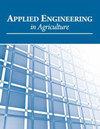基于微调三维cnn的农业行为识别模型比较研究
IF 0.8
4区 农林科学
Q4 AGRICULTURAL ENGINEERING
引用次数: 0
摘要
提出三维CNNS在农业行为识别中的应用。利用迁移学习加快了训练速度,提高了模型的准确性。构建了一个农业行为数据集,对其进行了扩展,并与以往的研究进行了比较。采用目标检测网络对数据进行预处理,取代了传统的预处理方法。摘要农业作物产量的质量和数量主要取决于各种实施农业行为的时机和精度。中国西南部以盆地和丘陵为主。由于地形的限制,该地区的农业机械化率仍然很低,农业仍然以非机械化为主。农业行为信息的获取和识别在作物生产中起着重要的作用。在本文中,迁移学习被用于当前最先进的基于3dcnn的行为识别模型中,用于农业行为识别和分类任务。重点是微调和评估用于农业行为识别的最先进的3D卷积神经网络。评估的体系结构包括Res3D、MC3和R2+1D。六种常见的耕作行为包括除草、种植、收获、移栽、施肥和喷洒。在Kinetics-400上预训练的所有模型经过微调后准确率均超过90%,其中MC3表现最好,准确率为0.9628,精密度为0.9647,灵敏度为0.963,特异度为0.9925,略高于其他两种模型。MC3也是所有车型中最轻的;其参数仅为Res3D的32.6%,R2+1D的36.7%。实验结果表明,微调后的MC3模型具有较高的分类精度和对农业行为的有效识别和分类,为提高作物产量奠定了良好的基础。关键词:深度学习,农业行为识别,农场管理,微调,精准农业,三维卷积神经网络,迁移学习本文章由计算机程序翻译,如有差异,请以英文原文为准。
A Comparative Study of Recognition Models Based on Fine-Tuning 3D CNNs for Farming Behaviors
Highlights Proposed application of 3D CNNS for recognition of farming behavior. Transfer learning was used to speed up training and improve model accuracy. A farming behavior dataset was constructed, expanded and compared with previous studies. An object detection network was used for data preprocessing rather than using traditional methods. Abstract. The quality and quantity of crop yields in agriculture primarily depend on the timing and precision of various implemented farming behaviors. Basins and hills dominate southwest China. Due to topographical constraints, the rate of agricultural mechanization in the region remains low, and agriculture remains primarily non-mechanized. The acquisition and recognition of information on farming behaviors play an important role in crop production. In this article, transfer learning was used in a current state-of-the-art 3DCNN-based behavior recognition model for farming behavior recognition and classification tasks. The focus was on fine-tuning and evaluating state-of-the-art 3D convolutional neural networks for farming behavior recognition. The evaluated architectures included Res3D, MC3, and R2+1D. The six common farming behaviors recognized include weeding, planting, harvesting, transplanting, fertilizing, and spraying. The accuracy of all models pretrained on Kinetics-400 after fine-tuning exceeded 90%, where MC3 had the best performance, with an accuracy of 0.9628, precision of 0.9647, sensitivity of 0.963, and specificity of 0.9925, which was slightly greater than the other two. MC3 was also the most lightweight of all models; its parameters were only 32.6% of Res3D and 36.7% of R2+1D. The experimental results demonstrated that the fine-tuned MC3 model offers high classification accuracy and effective recognition and classification of farming behaviors, which lays a good foundation for improved crop production. Keywords: Deep learning, Farming behavior recognition, Farm management, Fine-tuning, Precision agriculture, 3D convolutional neural networks, Transfer learning.
求助全文
通过发布文献求助,成功后即可免费获取论文全文。
去求助
来源期刊

Applied Engineering in Agriculture
农林科学-农业工程
CiteScore
1.80
自引率
11.10%
发文量
69
审稿时长
6 months
期刊介绍:
This peer-reviewed journal publishes applications of engineering and technology research that address agricultural, food, and biological systems problems. Submissions must include results of practical experiences, tests, or trials presented in a manner and style that will allow easy adaptation by others; results of reviews or studies of installations or applications with substantially new or significant information not readily available in other refereed publications; or a description of successful methods of techniques of education, outreach, or technology transfer.
 求助内容:
求助内容: 应助结果提醒方式:
应助结果提醒方式:


